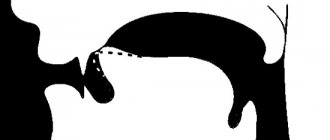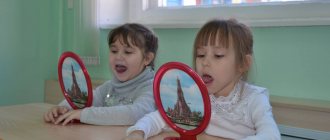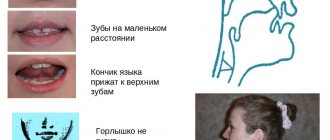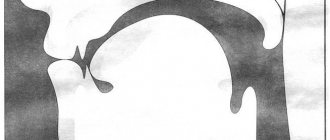Pronunciation problems
Defects
in
children, problems
associated with incorrect reproduction
of hard
“L” and soft “L” are usually divided into 2 large groups.
Presented in the table
:
| Group name | Type of deviation | Characteristic |
| Lambdacism | Nasal. | The child pronounces a sound with incorrect breathing. The air flow will enter the nasal passages. (“L” is replaced by “NG”). |
| Bilabial. | During pronunciation, the baby involuntarily makes a straw with his lips. It turns out that “L” is replaced with “U” (varnish with Uak; summer with Ueto, etc.) | |
| Interdental. | The tip of the tongue ends up in the interdental space. | |
| Absence of a letter in a conversation. | The child completely excludes the letter from the vocabulary (the lamp changes to Ampa). | |
| Paralambdacism (changes the phoneme to other sounds) | Replacing "L" with "V". Paw - Vapka; Moon - Vuna. | |
| Replacing "L" with "G". Chair – Stug; Meadow - Gug. | ||
| Replacing "L" with "D". Line - Desk; Fox - Dis. | ||
| Replacing the hard “L” with a soft one. Dala - Dalia. | ||
| Replacing “L” with “YA”, “Yo”, “YU”. Paw - Yapka; Spoon - Yozhka; Love - Yubov. | ||
Expert opinion
Margarita Sergeevna S.
Speech pathologist and speech pathologist with 15 years of experience working in various speech correction centers with children of different ages.
Any of the listed types of deviations can be eliminated with the help of speech therapy exercises and techniques.
Causes
In order to quickly form the correct
pronunciation
of a phoneme in a child, it is necessary to find out the root causes of the violations:
- bilingualism in the family;
- interdental pronunciation;
- the tongue is relaxed.
Note: Another reason for incorrect pronunciation of a sound is the age of the baby.
Children under 4 years old tend to make mistakes and confuse phonemes in words.
When such cases occur, the baby experiences incorrect placement of the speech organs. The position of the tongue is poorly designed, so the sound is distorted. There are situations when the defect is associated with breathing problems during a conversation:
- formation of phonemes with lips;
- the tip of the tongue does not touch the teeth. It just goes down and the sound is lost;
- the tip of the tongue is behind the lower teeth, and its middle is closer to the palate. When reproducing the phoneme “L” it should be the other way around.
Each of the above reasons is eliminated in individual lessons.
with a speech therapist and doing
homework .
to eliminate
deficiencies
in a short period of time, subject to regular work.
Important:
for dysarthria, it is necessary to perform complex exercises under the supervision of specialists. The presence of the disease presupposes a phased production of the phoneme “L”.
Correct articulatory position of the speech organs
When pronouncing “L”, the speech apparatus takes the position:
- Lips half open. The position is completely neutral to pronounce the vowel phoneme after the consonant sound.
- The upper and lower teeth are slightly open.
- The tip of the tongue rests on the upper jaw (teeth or gums). The rest of the tongue is completely down.
- The lateral edges of the tongue and the far teeth form a small space between each other on both sides. An air stream passes through the slots.
The formation of the soft sound "L" is slightly different. The lips assume the same position as when smiling. The tip of the tongue focuses on the alveoli (tubercles behind the front incisors). The rest of the tongue is slightly raised.
Demonstrated in pictures
,
how to put
the sounds “L” and “L”:
Correct articulation of "l"
When pronouncing any sound, certain organs work. The totality of their actions necessary for the speech apparatus to make a certain sound is called articulation. What organs are involved in the correct pronunciation of the sound “l”? These are lips, teeth, and tongue. All important articulatory instruments are involved. When pronouncing “l” correctly, the following happens:
- The lips occupy the position dictated by subsequent consonants and vowels
- The tip of the tongue rests on the upper incisors or their gums
- The edges of the palate, lips and the entire oral cavity are not connected to the upper incisors, so there are passages for exhaled air on the sides
- the root of the tongue rises when pronouncing the hard “L”
- the soft palate is also raised, blocking the passage into the nasal cavity
- The vocal cords should be closed and their vibration can be felt
Plan for the final lesson on speech development in the middle group
If all these conditions are met, the correct pronunciation of the hard sound “l” is obtained. For soft, there are a number of conditions:
- It is not the root of the tongue that is raised, but the anteromedial part of its back
- There is a closure of not only the tip of the tongue with the gums, but also most of the back of the tongue with the alveoli
- Often a soft “l” is produced if the tip of the tongue is lowered and the front part of the back closes with the alveoli
Some speech defects can be corrected by imitation. That is, by teaching the child to repeat sounds, syllables and words by ear. As experts note, in the case of the “l” sound, using only this method will not work. Precisely because of the complex articulatory work of organs. You will have to work on setting them up point by point. Especially if difficulties arise due to weak muscle tissue of the tongue.
Exercises for the speech apparatus
Articulation gymnastics —
the most important component of successfully overcoming
pronunciation
deficiencies Completing tasks
with an emphasis on the speech organs is
a preparatory stage
before setting the phoneme. Basic exercises for training the mobility of the lips and tongue:
- Hammock . Use the tip of your tongue to touch your upper teeth. The rest of the organ is bent downwards, forming a hammock. Stay in this position for 10-15 seconds.
-
. Move the wide tongue first along the upper, then along the lower lip. In this case, the lips should be motionless.
Delicious jam - Turkey . The tongue licks its lips at an accelerated pace. At this time, the child should try to say bl-bl-bl-bl.
Horse.
The baby is asked to imitate the clicking of an animal's hooves. The tip of the tongue flicks the roof of the mouth.- Wide smile.
The baby is asked to stretch his lips into a smile as far as possible and freeze in this position for a few seconds. The exercise will be repeated 2-3 times.
Note: classes help train articulation
if it is difficult to place any types of phonemes - voiceless or voiced , hard or soft, etc.
Breathing exercises
The sounds “L” and “L” are produced as you exhale. To correctly place the phoneme, experts recommend regularly performing inhalation-exhalation exercises:
- Stop, horse! Take a deep breath, and as you exhale say br-br-br.
- Ball.
The baby is asked to lie down on the floor. Hands are placed on the tummy. As you inhale, the “ball” (tummy) inflates, and as you exhale, it deflates. - Ship. A paper boat is lowered into a basin of water. The baby is offered to move it with a stream of air.
Breathing exercises are performed for 2-3 minutes daily.
Advice: a detailed
work plan and more detailed methods of training the speech organs are provided by a speech therapist. The specialist will explain how to quickly and effectively carry out the exercises.
Preliminary articulation exercises
Before moving directly to exercises for making the sound “l”, experts advise doing a series of articulation tasks, the so-called articulatory gymnastics, which precedes the approach to making the sound “l”. This is a kind of tuning of the speech apparatus to master the rebellious sound. Here we work on the movements of the lips and tongue.
To begin with, the child is told and shown the structure of the mouth: lips, upper and lower; behind them are the teeth, upper and lower; at the top - a tubercle; behind it is the hard palate, it continues with the soft palate and ends with the velum palatine, on which there is a uvula. If a child is diagnosed with lambdacism in any form, then first you need to do the following articulation exercises (perform every day in front of the mirror, counting from one to five, for five to ten minutes, twice a day):
- “Smile” - part your lips into a smile, exposing your upper and lower teeth.
- “Tube” - lips are closed and extended forward.
- “Tongue punishment” - the tongue remains on the lower lip, it is spanked, saying “Pa-pa-pa.”
- “Cleaning the upper teeth” (from the inside) - the tongue is made wide, it is moved from side to side at the upper tubercles, also known as alveoli.
- “Sail” - the tip of the tongue should be rested on the row of upper front teeth. The tongue is like a hammock that has sagged. There is no need to move the tongue, it is simply held in this position while counting. The longer you can hold on, the better.
- “The cat drinks milk” - a wide tongue licks the upper lip from top to bottom.
- “Turkey chatter” is the same as in the “cat” exercise, but the movements are fast and accompanied by the sounds “bl-bl-bl-...”.
- “Swing” - with your mouth slightly open, you need to smile widely. On the count of “1-2”, the tip of the tongue rests on the upper and then on the lower incisors (from their inner side).
- “Horse” - click the wide tip of the tongue on the palate behind the upper front incisors. The mouth is open, but the lower jaw does not move at all.
- “Fungus” - the tongue seems to be glued to the palate, the hyoid frenulum is tense.
It is recommended to carry out such gymnastics for two to four weeks. In this way, the skill is developed to fix the necessary articulatory posture, accurately make all movements and monitor the lips, tongue and the entire speech apparatus.
Methods for making the sounds L and L
What sound can you make the sound L from?
determined individually for each child, taking into account capabilities and skills. In speech therapy practice, the following methods are distinguished:
- By imitation. Performed while sitting in front of a mirror. The baby is shown the correct location of the speech organs in the reflection and asked to repeat. After a successfully completed task, they are asked to sound out the letter in this position.
Note: the lesson is most suitable for children with a complete absence of phonemes in words, when there is no need to rearrange the established positions of organs during reproduction.
- Setting from the letter “Y”. Occurs in a playful way, simulating a steamship. The baby is asked to smile broadly. Lightly bite your tongue and pronounce the sound “Y” in a drawn-out manner. It will smoothly turn into a drawn-out l-l-l. You can try this exercise with other vowel sounds.
- Setting from the letter "B". The lesson is aimed at inhibiting the lower lip. When pronouncing the letter “B”, the baby should not move his lower lip. If it doesn’t work, the adult holds the sponge with his finger. For preschoolers
, they read special
poems
or sing
songs
with an abundance of the letter “L” in the words and ask them to repeat. - Production from the sound “L”. A soft sound is pronounced more readily by a child. It does not require tongue tension and is faster. To get a solid phoneme, the baby is asked to reproduce syllables
(La, Lo, Lu). At the same time, they are asked to reach the upper lip with the tip of their tongue. - Mechanical method. Performed using a special tool or clean fingers. Carry out the manipulation only under the supervision of a speech therapist or with his participation. The tongue is asked to be lifted by the upper incisors. The instrument maintains it at the desired level during pronunciation of the phoneme. The method is suitable for patients with dysarthria.
Expert opinion
Margarita Sergeevna S.
Speech pathologist and speech pathologist with 15 years of experience working in various speech correction centers with children of different ages.
The above methods can be performed one at a time or several can be used at once. All the secrets
You can learn how to perform the techniques during a consultation with a speech therapist.
Speech therapy exercises for the sound “L”
After mastering articulatory gymnastics, you can proceed directly to producing the sound “l”. The following exercises are used:
Modern methods and games for teaching speech for non-speaking children
1. Imitation method: the student is shown how to correctly articulate the sound “l”. Smile, open your mouth slightly, open your teeth so that you can place your finger between the upper and lower teeth. The wide tip of the tongue rises and presses against the tubercles, when exhaling, the air flows along the sides, the cheeks vibrate. The child pronounces “l” after the adult. The sound should be produced when the tongue is torn away from the tubercles.
2. Setting from interdental sound (this method is not used if the defect is due to interdental lambdacism). An adult tells a fairy tale “About a steamboat that learned to whistle.”
“Once upon a time, a very tiny one sailed along the sea along with large steamships. He did everything the same as adults, but no one paid attention to him. All because he did not know how to speak - to make a steamship whistle. Instead of the beautiful “L”, he made some incomprehensible and very timid sounds. One day the steamboat decided to learn how to talk and hum like a big one. He learned by saying: “U!O! Everything is wrong." Nobody answered him and there was no dial tone. The steamboat was so upset that he bit his tongue and said: “Y.” Then an amazing thing happened: a clear and clear “L” flashed over the sea. The steamboat said it. He thought, “It must have seemed like it,” and tried again. He bit his tongue again and said: “Y.” It turned out to be a beautiful “L”. And suddenly large steamships began to answer him from all sides: “L!” "L!" So all the big ships learned about the tiny steamer, and it became heard throughout the whole sea.”
After listening to this fairy tale, the child performs all the actions behind the steamboat. He, like a fairy-tale character, may not immediately, but he should get the sound “L”. After this has happened, it must be combined with vowels. It is allowed in the reverse order IL, YL, OL, etc.
3. Method for bilabial lambdacism.
The main thing in this exercise is to learn to subjugate unruly lips. Often they are to blame for poor pronunciation - they stretch out into a tube, wrap themselves up and produce the sound “v” at the output. Speech therapists associate the inability to position the lips correctly with a long period of weaning from the pacifier. The “Smile” and “Fence” exercises are recommended: the lips are specially stretched as much as possible in a smile, the front teeth are exposed and clenched. This position must be fixed and maintained for as long as possible. At first you can’t do this without the help of an adult - you need to hold your lips, parting them into a smile.
4. Setting “L” from soft “L”
At first, learning is possible by pronouncing a soft sound instead of the correct “L”. Then it should be “tidied up” by teaching the child to pronounce the syllables LO, LU, LY, LA, touching the upper lip with the end of the tongue. And gradually removing it behind the upper teeth. It is recommended to massage the muscles around the mouth and lightly spank them with your fingers.
Three exercises to relax your muscles:
- “The horse snorts” - blow hard on your lips, imitating a horse.
- “Fish” - slap your lips together, imitating a fish.
- “Tired” - blow hard on parted lips.








